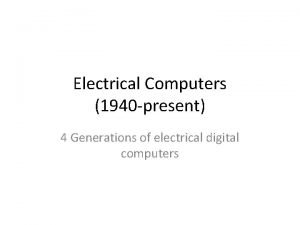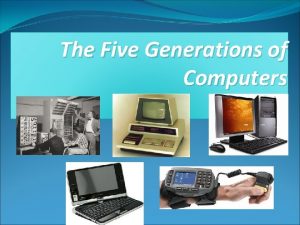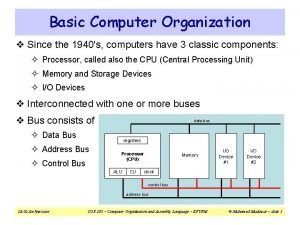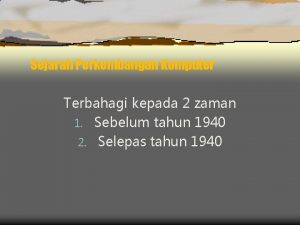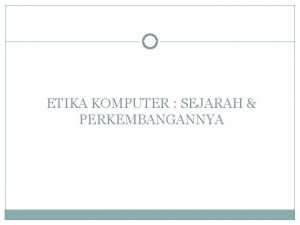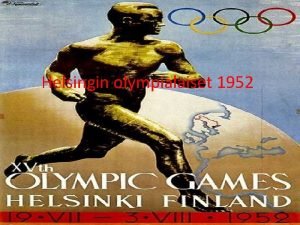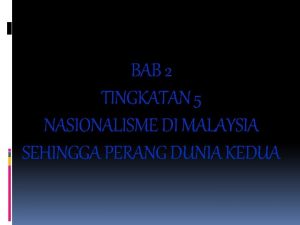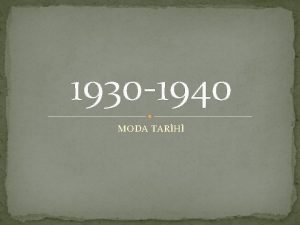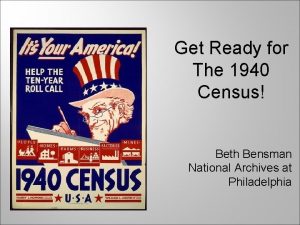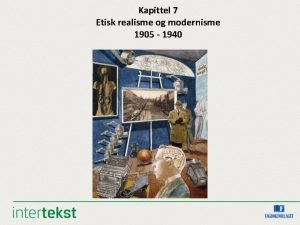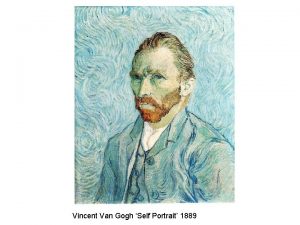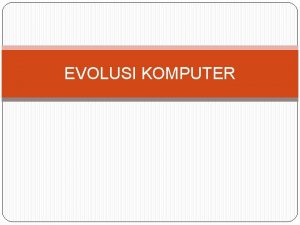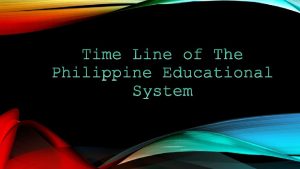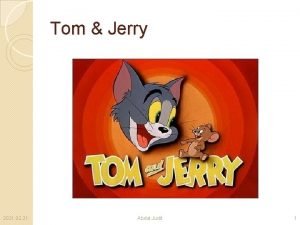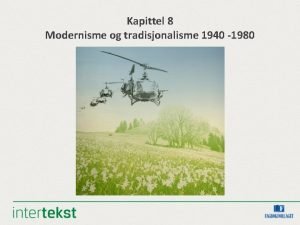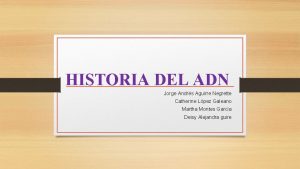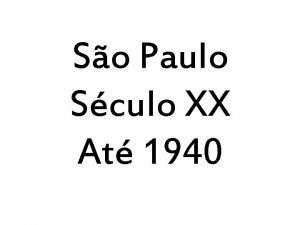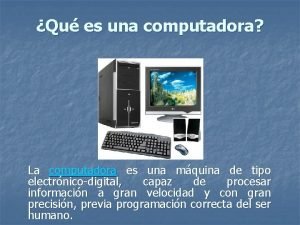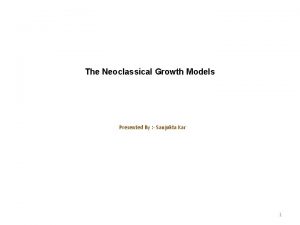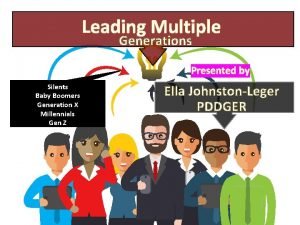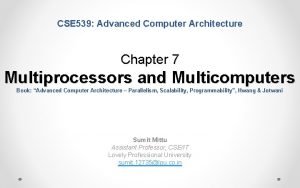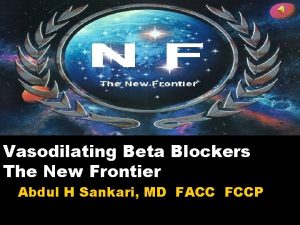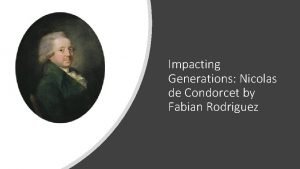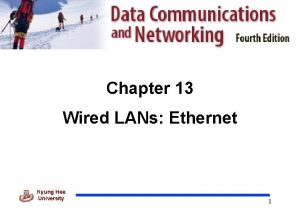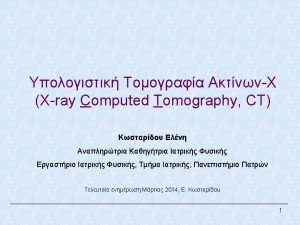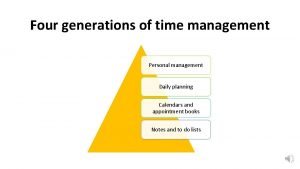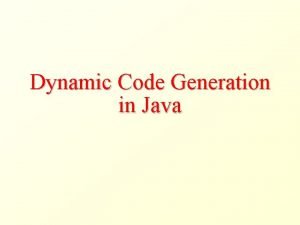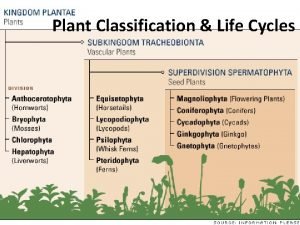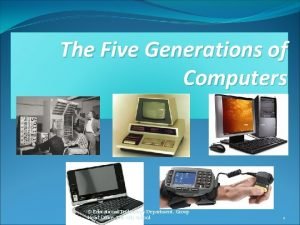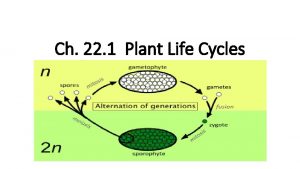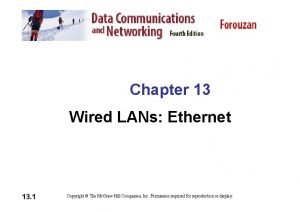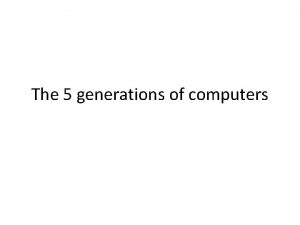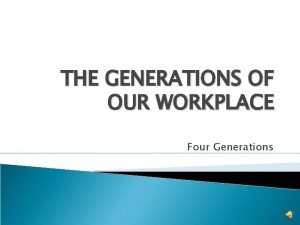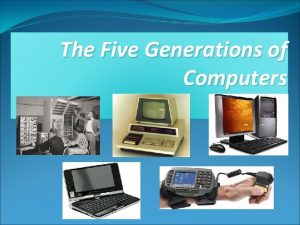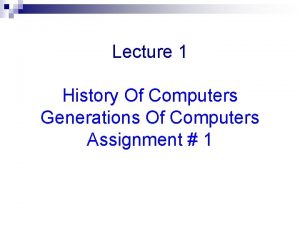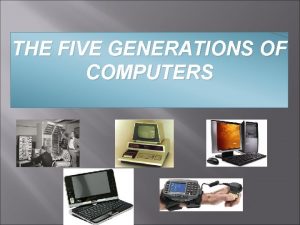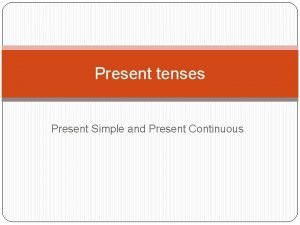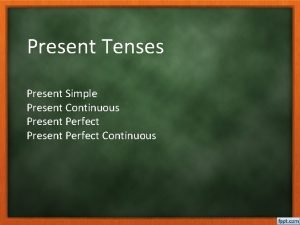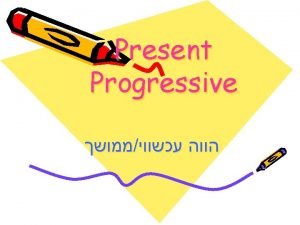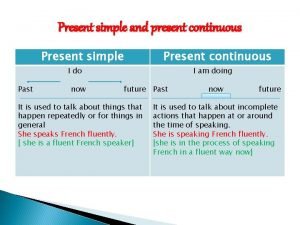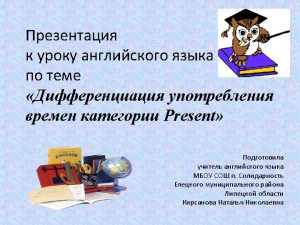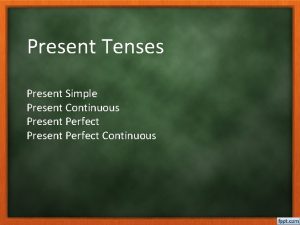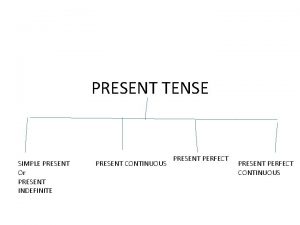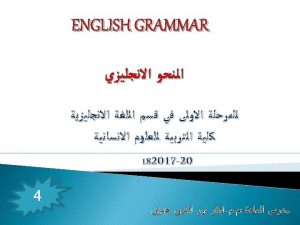Electrical Computers 1940 present 4 Generations of electrical






















































- Slides: 54

Electrical Computers (1940 -present) 4 Generations of electrical digital computers

First mechanical-electrical computers

Konrad Zuse’s Z 1, Z 2, Z 3, Z 4 (Germany, 1938 -1949) • Zuse invented Z 1, a mechanical computer in 1938 in his parent’s flat • Never worked due to insufficient mechanical precision • Used 22 -bit floating point binary numbers • Read instructions from a tape perforated 35 mm film • Limited programmability (9 instructions; 1 instruction took 1 -20 cycles) • An electrical motor gave the clock frequency of 1 Hz • Weighted 1000 kg and had mechanical metal parts and a few electrical relays • The design documents were destroyed in 1944 by British bombing

Z 1, 1938

Z 2, 1939 • Similar to Z 1, but implemented the arithmetic and control unit using electrical relays • Had the same mechanical memory with 64 words • Used 16 -bit floating point arithmetic • Clock frequency of 5 Hz • An addition operation took 0. 8 seconds • Weighted 300 kg and consumed 1000 watts

Z 2, 1939

Z 3, 1941 • • • An electromechanical computer The world’s first working, programmable digital computer Used 2000 electrical relays Had a clock frequency of 5. 3 Hz Arithmetic unit: add, substract, multiply, divide, square root 22 -bit floating point numbers Program and data were stored on punched tape film Was Turing-complete, had loop instructions, but no conditional Addition took 0. 8 seconds, multiplication took 3 seconds Weighted 1000 kg and consumed 4000 Watts

Z 3, 1941

Z 4, 1945 • Zuse realized it is difficult to program in machine code, so he invented a programming language, Plankalkül • Had a frequency of 40 Hz • Addition – 400 ms, multiplication – 3 seconds • Input/output on punch tape and programs were written on 35 mm punched film • Used 32 -bit floating points • Used 2. 500 relays • Consumed 4 KWatts of power

Z 4, 1945

First generation computers (based on vacuum tubes): 1940 -1960

Vacuum tubes

Colossus, UK, 1943 -1945 • Developed by British codebreakers to break the Lorenz German cipher; used only for decrypting messages • Used vacuum tubes • It was programmed by switches and plugs and not by a stored program • Had no memory, input on paper tape, output – electric type writer

Colossus

ENIAC, US, 1946 • A Turing-complete, electrical general-purpose computer • ENIAC = Electronic Numerical Integrator and Computer • Built by John Mauchly and J. Presper Eckert from Univ. Pensylvannia for US Army • Could calculate a bomb trajectory in 30 seconds (a human would do it in 20 hours) • It cost 487. 000 $ (equiv. to 6. 887. 000 $ in today’s money) • contained 20, 000 vacuum tubes, 7200 crystal diodes, 1500 relays, 70, 000 resistors, 10, 000 capacitors and approximately 5, 000 hand-soldered joints • Weighted 27 tons, occupied 167 squared meters, consumed 150 KWatts of electricity • Input/output on IBM punched cards

ENIAC, US, 1946 • Had a 100 -word magnetic memory • Could do 385 multiplications / second, 40 divisions / second and 3 square root / second • 200 micro second cycles (100 KHz) • Could perform complex sequences of operations, including loops, branches, and subroutines but not with stored programs, but with manual switches • Very unreliable, vacuum tubes would break daily – longest runtime approx. 5 days

ENIAC

EDVAC, US, 1949 • EDVAC = Electronic Discrete Variable Automatic Computer • built by John Mauchly and J. Presper Eckert and John von Neumann for the US Ballistics Research Laboratory • Cost similar to ENIAC (500. 000 $) • Used a binary system (not decimal like ENIAC) and stored programs in memory • Could do an addition in 867 micro seconds and a multiplication in 2, 9 milliseconds • Had a memory of approx. 5. 5 KB • had almost 6, 000 vacuum tubes and 12, 000 diodes, and consumed 56 k. W of power; occupied 45. 5 sq. meters, weighted 7, 8 tons • Ran 20 hours per day

EDVAC

Harvard Mark I-IV, US, 1944 - 1952 • IBM Automatic Sequence Controlled Calculator (ASCC) • was built from switches, relays, rotating shafts, and clutches. • It used 765, 000 electromechanical components and hundreds of miles of wire • comprising a volume of 23 m 3 (16 m x 2. 4 m x 0. 61 m) • It weighed about 4, 500 kg • could do 3 additions or subtractions in a second • a multiplication took 6 seconds, a division took 15. 3 seconds, and a logarithm or a trigonometric function took over one minute

Harvard Mark I

Manchester Mark I, UK, 1948 • Developed at the University of Manchester • Consumed 25 Kwatts • Used 40 -bit words

Manchester Mark I

Second generation computers (based on transistors): 1950 -1970

Transistors • Invented by John Bardeen, William Shockley and Walter Brattain at Bell Labs, 1948. • Used as an electric amplifier or electronic switch • Transistor Logic gates Adder ALU (Arithmetic and Logic Unit) in a CPU

Transistors (2) Replica of the first working transistor

AND logic gate implemented with 2 transistors

Logic gates

Adder using XOR and AND gates

IBM 306, 1957

IBM 306, 1957 • Had more than 3000 germanium transistors • Was programmable using an electric control panel • Could store 40 nine-digit numbers in the memory (magnetic core) • it could perform 4, 500 additions per second • it could multiply 2 nine-digit numbers, yielding an 18 -digit result in 11 milliseconds • it could divide an 18 -digit number by a nine-digit number to produce the nine-digit quotient in 13 milliseconds. • was supplied with a type 535 card reader/punch which had its own control plugboard

Olivetti Elea 9003, Italy, 1959

Olivetti Elea 9003, Italy, 1959 • • • Run 8 -10000 instructions per second Stored 160. 000 words in the memory Mass storage was on magnetic tape Input on punched paper tape or punched cards Output on line printer

IBM 7007, 1958

IBM 7007, 1958 • • IBM’s first stored-program computer CPU speed 27 KIPS Cost $813. 000 Disk storage with a capacity of 6 million digits

Honeywell 200, US, 1960

Honeywell 200, US, 1960 • • Used 6 -bit characters Could store 524. 288 characters in the main storage Addition would take 12 useconds Had COBOL and Fortran compilers

PDP-8, US, 1965

IBM M 44/44 X, US 1965

IBM M 44/44 X, US 1965 • Was pure experimental, for research • Explored memory paging • Simulated virtual machines

Third generation computers (based on the microchip): 1960 -present

The microchip • The integrated circuit (i. e. microchip) was invented independently by Jack Clair Kilby and Robert Noyce • A set of electronic circuits on a small flat piece of semiconductor material, silicon • Integrated many tiny transistors • Moore’s law: number of transistors in an integrated circuit doubles every two years • As of 2016, typical chip areas range from a few square millimeters to around 600 mm 2, with up to 25 million transistors per mm 2

Moore’s law

The microchip Jack Kilby’s original prototype

Third generation computers • • • IBM-360 series Honeywell-6000 series IBM-370/168 TDC-316 PDP

Fourth generation computers (based on the microprocessor): 1971 -present

Intel 4004, first microprocessor

Intel 4004 • Invented by Intel in 1971 • Incorporates CPU functions in a single integrated circuit • microprocessor is a multipurpose, clock driven, register based, digital-integrated circuit which accepts binary data as input, processes it according to instructions stored in its memory, and provides results as output • Operates with binary numbers • Clock frequency 740 KHz • Instruction cycle: 10. 8 us

Microcomputers, Personal Computers

IBM-PC 5150, 1981

Altair 8800, 1974

IMSAI 8080, 1975

Apple I, 1976

Apple II, 1977
 Edvac full form
Edvac full form Third generation of computer
Third generation of computer Art deco 1925
Art deco 1925 Basic computer organization
Basic computer organization Sejarah perkembangan komputer
Sejarah perkembangan komputer Etika komputer
Etika komputer From 1900 to 1940, research in nursing focused on:
From 1900 to 1940, research in nursing focused on: Helsingin olympialaiset 1940
Helsingin olympialaiset 1940 Kallocain analysis
Kallocain analysis Who translated pakistan resolution in urdu
Who translated pakistan resolution in urdu 1930-1939 fashion
1930-1939 fashion Baltic states 1940
Baltic states 1940 Sumbangan mohammad eunos abdullah sejarah
Sumbangan mohammad eunos abdullah sejarah 1940 moda
1940 moda 1940 census.archives.gov
1940 census.archives.gov 50-luvun muoti
50-luvun muoti Ve day times square
Ve day times square 1940 spinning top
1940 spinning top Hva er strofer
Hva er strofer Van gogh self portrait 1889
Van gogh self portrait 1889 Frida kahlo self portrait with monkey 1940
Frida kahlo self portrait with monkey 1940 Evolusi komputer
Evolusi komputer Ra no. 5250
Ra no. 5250 Tom és jerry 2021 teljes film magyarul videa
Tom és jerry 2021 teljes film magyarul videa Tarjei vesaas modernismen
Tarjei vesaas modernismen Regla de erwin chargaff 1940
Regla de erwin chargaff 1940 Camaro 1940
Camaro 1940 Que es una computadora
Que es una computadora Overlapping generations model
Overlapping generations model Generations in order
Generations in order Unicast
Unicast Generations overview
Generations overview Sustainable development future generations
Sustainable development future generations Hvad er bioethanol
Hvad er bioethanol Message routing schemes in computer architecture
Message routing schemes in computer architecture Generations of beta blockers
Generations of beta blockers Future generations collaborative
Future generations collaborative Nicolas generations
Nicolas generations Generations of supraglottic airway devices
Generations of supraglottic airway devices First generation of computer advantages
First generation of computer advantages Come lord jesus come and be born in our hearts lyrics
Come lord jesus come and be born in our hearts lyrics Wired lans ethernet
Wired lans ethernet Organic basics proff
Organic basics proff Alternation of generations
Alternation of generations A plant's life cycle alternates between and generations.
A plant's life cycle alternates between and generations. Generations youth
Generations youth Generations
Generations 4 generations of time management
4 generations of time management Java runtime code generation
Java runtime code generation Alternation of generations
Alternation of generations Five generation of computer
Five generation of computer Ganetophyte
Ganetophyte Todays generations
Todays generations Generations in a pedigree
Generations in a pedigree First ethernet
First ethernet
